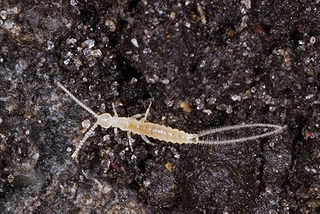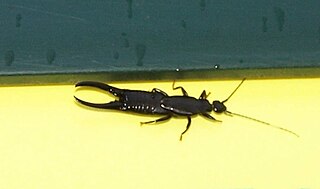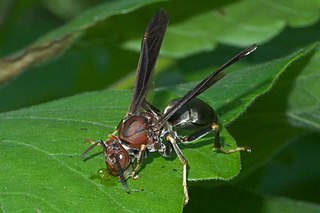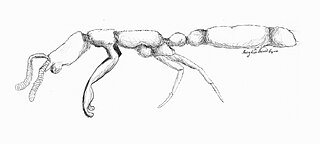
The order Diplura is one of three orders of non-insect hexapods within the class Entognatha. The name "diplura", or "two tails", refers to the characteristic pair of caudal appendages or filaments at the terminal end of the body.

Earwigs make up the insect order Dermaptera. With about 2,000 species in 12 families, they are one of the smaller insect orders. Earwigs have characteristic cerci, a pair of forcep-like pincers on their abdomen, and membranous wings folded underneath short, rarely used forewings, hence the scientific order name, "skin wings". Some groups are tiny parasites on mammals and lack the typical pincers. Earwigs are found on all continents except Antarctica.

Forficula auricularia is a species complex comprising the common earwig or European earwig, an omnivorous insect in the family Forficulidae. The European earwig survives in a variety of environments and is a common household insect in North America. The name earwig comes from the appearance of the hindwings, which are unique and distinctive among insects, and resemble a human ear when unfolded; the species name of the common earwig, auricularia, is a specific reference to this feature. They are considered a household pest because of their tendency to invade crevices in homes and consume pantry foods, and may act either as a pest or as a beneficial species depending on the circumstances.

Histeridae is a family of beetles commonly known as clown beetles or hister beetles. This very diverse group of beetles contains 3,900 species found worldwide. They can be easily identified by their shortened elytra that leaves two of the seven tergites exposed, and their geniculate (elbowed) antennae with clubbed ends. These predatory feeders are most active at night and will fake death if they feel threatened. This family of beetles will occupy almost any kind of niche throughout the world. Hister beetles have proved useful during forensic investigations to help in time of death estimation. Also, certain species are used in the control of livestock pests that infest dung and to control houseflies. Because they are predacious and will even eat other hister beetles, they must be isolated when collected.
A trophic egg is an egg whose function is not reproduction but nutrition; in essence, the trophic egg serves as food for offspring hatched from viable eggs. In most species that produce them, a trophic egg is usually an unfertilised egg. The production of trophic eggs has been observed in a highly diverse range of species, including fish, amphibians, spiders and insects. The function is not limited to any particular level of parental care, but occurs in some sub-social species of insects, the spider A. ferox, and a few other species like the frogs Leptodactylus fallax and Oophaga, and the catfish Bagrus meridionalis.

The Saint Helena earwig or Saint Helena giant earwig is an extinct species of very large earwig endemic to the oceanic island of Saint Helena in the south Atlantic Ocean.

The Eucharitidae are a family of parasitic wasps. Eucharitid wasps are members of the superfamily Chalcidoidea and consist of three subfamilies: Oraseminae, Eucharitinae, and Gollumiellinae. Most of the 55 genera and 417 species of Eucharitidae are members of the subfamilies Oraseminae and Eucharitinae, and are found in tropical regions of the world.

Sociality is the degree to which individuals in an animal population tend to associate in social groups (gregariousness) and form cooperative societies.

Ant mimicry or myrmecomorphy is mimicry of ants by other organisms; it has evolved over 70 times. Ants are abundant all over the world, and potential predators that rely on vision to identify their prey, such as birds and wasps, normally avoid them, because they are either unpalatable or aggressive. Some arthropods mimic ants to escape predation, while some predators of ants, especially spiders, mimic them anatomically and behaviourally in aggressive mimicry. Ant mimicry has existed almost as long as ants themselves; the earliest ant mimics in the fossil record appear in the mid-Cretaceous alongside the earliest ants.

Myrmecophagy is a feeding behavior defined by the consumption of termites or ants, particularly as pertaining to those animal species whose diets are largely or exclusively composed of said insect types. Literally, myrmecophagy means "ant-eating" rather than "termite eating". The two habits often overlap, as both of these eusocial insect types often live in large, densely populated nests requiring similar adaptations in the animal species that exploit them.

Coccinellidae is a widespread family of small beetles. They are commonly known as ladybugs in North America and ladybirds in the United Kingdom; "lady" refers to mother Mary. Entomologists use the names ladybird beetles or lady beetles to avoid confusion with true bugs. The more than 6,000 described species have a global distribution and are found in a variety of habitats. They are oval beetles with a domed back and flat underside. They are sexually dimorphic; adult females are larger than males. Many of the species have conspicuous aposematic (warning) colours and patterns, such as red with black spots, that warn potential predators that they taste bad.

A wasp is any insect of the narrow-waisted suborder Apocrita of the order Hymenoptera which is neither a bee nor an ant; this excludes the broad-waisted sawflies (Symphyta), which look somewhat like wasps, but are in a separate suborder. The wasps do not constitute a clade, a complete natural group with a single ancestor, as bees and ants are deeply nested within the wasps, having evolved from wasp ancestors. Wasps that are members of the clade Aculeata can sting their prey.

The ringlegged earwig is a species of earwig in the family Anisolabididae.

Chelisoches morio, also known as the black earwig, are part of the family Chelisochidae. It is an omnivore that can be found worldwide, however it is most prominent in tropical areas, Pacific islands, the Pacific Northwest, and damp environments. The adults are jet black and can range in size from 18 to 25mm in size, though some have grown to be 36mm. The males cerci are widely separated and serrated compared to the female. The forceps are used for prey capture, defense, fighting and courtship.

Polistes metricus is a wasp native to North America. In the United States, it ranges throughout the southern Midwest, the South, and as far northeast as New York, but has recently been spotted in southwest Ontario. A single female specimen has also been reported from Dryden, Maine. Polistes metricus is dark colored, with yellow tarsi and black tibia. Nests of Polistes metricus can be found attached to the sides of buildings, trees, and shrubbery.

Leptanilla japonica is an uncommon highly migratory, subterranean ant found in Japan. They are tiny insects, with workers measuring about 1.2 mm and queens reaching to about 1.8 mm, and live in very small colonies of only a few hundred individuals at a time Its sexual development follows a seasonal cycle that affects the colony's migration and feeding habits, and vice versa. L. japonica exhibits specialized predation, with prey consisting mainly of geophilomorph centipedes, a less reliable food source that also contributes to their high rate of nest migration. Like ants of genera Amblyopone and Proceratium, the genus Leptanilla engages in larval hemolymph feeding (LHF), with the queen using no other form of sustenance. LHF is an advantageous alternative to the more costly cannibalism. Unlike any other ant, however, members of Leptanilla, including L. japonica, have evolved a specialized organ dubbed the “larval hemolymph tap” that reduces the damage LHF inflicts on the larvae. LHF has become this species' main form of nutrition.
Mischocyttarus drewseni, which is sometimes spelled "drewsenii", is a social wasp in the family Vespidae. It is commonly found in Neotropical regions of South America, including Brazil, Peru, Venezuela, Colombia and Paraguay. This mid-sized wasp is about 1.5-1.8 cm and is typically dark brown or black in color. This species makes their nests out of woody plant fibers and create single combed nests with hexagonal cells which are typically found in low lying grass habitats or semi-urban environments. The colony cycle for this species is initiated by the queen who starts building the nest cell by cell. The nest construction process is highly elaborate and involves foraging for materials, creating cells, and heightening cell walls. It feeds on arthropods, plant nectar, and honeydew, and the species is very protective of its brood when it comes to defending them from their predators. The life cycle of this species has several stages with varying lengths, including egg, larval, pupal, and adult stages. As a social wasp species, there are several castes within the colony and different castes perform different specialized jobs with differing dominance and reproductive behaviors.

Mischocyttarus flavitarsis is a social paper wasp found in western North America. Their nests can be found both in forests close to rivers or in close proximity to human life under the eaves of roofs. Despite the fact that M. flavitarsis nests are frequently in close contact with humans, M. flavitarsis typically will not sting, but rather ram into the threatening individual. Their colony cycle typically begins before May and will last until October. The queen will then seek a hibernation site for the winter. Perched near female hibernation sites are males with whom the female will mate. The males have claimed their territory by rubbing sternal brushes along the border of the site, leaving a chemical that deters other individuals from approaching. M. flavitarsis feed on arthropods, nectar, and animal carcasses and are often prey to birds, ants, and praying mantis.

Mischocyttarus mexicanus cubicola is a neotropical subspecies of paper wasp found in the New World. It is a social wasp that demonstrates two different types of nesting strategies, depending upon context. This context-dependent trait makes Mischocyttarus mexicanus cubicola a good model to study social biology within social wasps. In detail, this trait allows for the females of this species to form nests both individually and as co-founders with other females within the same colony. This subspecies is also known to exhibit cannibalism, with M. m. cubicola queens feeding on their own larvae for nourishment when unaided by workers.

Mallophora bomboides, also known as the Florida bee killer, is a predaceous species of robber fly of the family Asilidae that feeds primarily on bumblebees. M. bomboides is a noteworthy instance of Batesian mimicry given its close resemblance to its prey, the bumblebee. These bees are typically found in the Eastern and Southern regions of the United States like South Carolina and Florida.




















